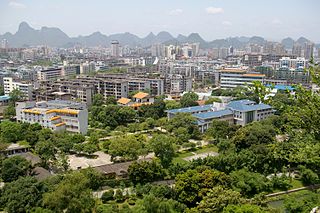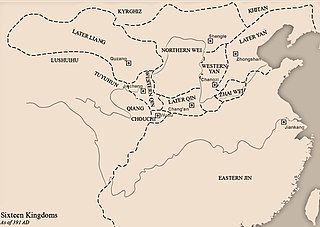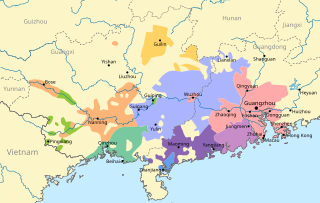
Shanxi is a landlocked province in North China. The capital and largest city of the province is Taiyuan, while its next most populated prefecture-level cities are Changzhi and Datong. Its one-character abbreviation is "晋", after the state of Jin that existed here during the Spring and Autumn period.

Yue or Yueh is a group of similar Sinitic languages spoken in southern China, particularly the provinces of Guangdong and Guangxi, which are collectively known as Liangguang.

Guilin is a prefecture-level city in the northeast of China's Guangxi Zhuang Autonomous Region. It is situated on the west bank of the Li River and borders Hunan to the north. Its name means "Forest of Sweet Osmanthus", owing to the large number of fragrant sweet osmanthus trees located in the region. The city has long been renowned for its scenery of karst topography.

The Lingqu is a canal in Xing'an County, near Guilin, in the northwestern corner of Guangxi, China. It connects the Xiang River with the Li River, and thus is part of a historical waterway between the Yangtze and the Pearl River Delta. It was the first canal in the world to connect two river valleys and enabled boats to travel 2,000 kilometres (1,200 mi) from Beijing to Hong Kong.

Taiyuan is the capital and largest city of Shanxi province in Northern China. It is one of the main manufacturing bases of China. Throughout its long history, Taiyuan was the capital or provisional capital of many dynasties in China, hence the name Lóngchéng.

The Former Qin (351-394) was a state of the Sixteen Kingdoms in eastern Asia, mainly China. Founded by an officer Fu Jian (317–355) in Shi Le's dynasty, it completed the unification of North China in 376. Its capital was Xi'an up to the death of the ruler Fu Jian (337–385) in 385. Despite its name, the Former Qin was much later and less powerful than the Qin Dynasty which had ruled all of China during the 3rd century BC. The adjective "former" is used to distinguish it from the "Later Qin" state (384-417).

The Western Yan was a state of Xianbei ethnicity during the era of Sixteen Kingdoms in China. It was founded by Murong Hong in 384 in the aftermaths of Former Qin's defeat by Jin Dynasty (265-420) at the Battle of Fei River, with the stated intent of permitting the Xianbei, whom Former Qin's emperor Fu Jiān had relocated to Former Qin's capital region after destroying Former Yan in 370. It initially also was intended to rescue the last Former Yan emperor Murong Wei, until he was executed by Fu Jiān in 385. It was a state that was characterized by extreme political instability and internal fighting, as all seven of its rulers died of unnatural causes. After eviscerating Former Qin, the people of the state abandoned the Guanzhong region and headed east back toward their homeland, but eventually settled down in modern Shanxi. It was destroyed in 394 as Later Yan's emperor Murong Chui wanted to reunite the people formerly of Yan and conquered it.

The Central Plains War was a series of military campaigns in 1929 and 1930 that constituted a Chinese civil war between the Nationalist Kuomintang government in Nanjing led by Generalissimo Chiang Kai-shek and several regional military commanders and warlords that were former allies of Chiang.

Tongguan County is a county in the east of Shaanxi province, China, administered as part of the prefecture-level city of Weinan. It is named after the Tong Pass, located south of the confluence of the Wei and Yellow Rivers. It is the southeastern corner of the Ordos Loop, the point at which the Qin Mountains turn the Yellow River sharply eastward, forcing it into the North China Plain, and borders the provinces of Shanxi to the north and Henan to the east.

Dai County, also known by its Chinese name Daixian, is a county in Xinzhou, Shanxi Province, China. Its county seat at Shangguan is also known as Daixian. The county has an area of 1,729 km2 (668 sq mi) and had a population of 214,091 at the time of the 2010 census. The county is the home of the AAAAA-rated Yanmen Pass Scenic Area along the Great Wall, as well as the Bianjing Drum Tower, the Ayuwang Pagoda, and the Zhao Gao Forest Park.

Zhongyuan, Chungyuan, or the Central Plain, also known as Zhongtu, Chungtu or Zhongzhou, Chungchou, is the area on the lower reaches of the Yellow River which formed the cradle of Chinese civilization. It forms part of the North China Plain.

The Lüliang Mountains are a mountain range in central China, dividing Shanxi's Fen River valley from the Yellow River. The range forces the Yellow River southwards on the eastern side of the Ordos Loop but tapers off to the south, where the Fen turns west to join the Yellow River before the Qin Mountains turn the combined river sharply eastward at its confluence with the Wei at Tongguan in Shaanxi.

China National Highway 209 (G209) runs from Hohhot, Inner Mongolia to Beihai, Guangxi province. It is 3,435 kilometres in length and runs south from Huhhot towards Shanxi province, Henan province, Hubei province, Hunan province, and ends in Guangxi province.

The Sixteen Kingdoms, less commonly the Sixteen States, was a chaotic period in Chinese history from 304 to 439 CE when the political order of northern China fractured into a series of short-lived dynastic states, most of which were founded by the "Five Barbarians," non-Chinese peoples who had settled in northern and western China during the preceding centuries and participated in the overthrow of the Western Jin dynasty in the early 4th century. The kingdoms founded by ethnic Xiongnu, Xianbei, Di, Jie, Qiang, as well as Chinese and other ethnicities, took on Chinese dynastic names, and fought against each other and the Eastern Jin dynasty, which succeeded the Western Jin and ruled southern China. The period ended with the unification of northern China in the early 5th century by the Northern Wei, a dynasty established by the Xianbei Tuoba clan, and the history of ancient China entered the Northern and Southern dynasties period.

The Nanpan River has its source in the Yungui Plateau of eastern Yunnan Province. It then flows east, forming part of the border between Guizhou and Guangxi provinces. It joins with the Beipan River to become the Hongshui River. It is roughly 950 km (590 mi) long.

Qin–Lian is a southern branch of Yue Chinese spoken in the coastal part of Guangxi, which is represented by four traditional cities Qinzhou, Lianzhou, Lingshan and Fangcheng ("欽廉靈防") or by three modern prefecture-level cities Qinzhou, Beihai and Fangcheng ("欽北防").
The Qin River is a tributary of the Yellow River in southeast Shanxi, China. It rises in Qinyuan County, Shanxi, and joins the Yellow River in Wuzhi County, Henan. The river is 485 km (301 mi) long and has a catchment area of 13,500 km2 (5,200 sq mi). Its largest tributary is the Dan River (丹河).
Qin Jianxiao is a former Chinese politician from Shanxi province. During his career he has served as the Mayor of Gaoping, the Communist Party Secretary of Qinshui County, and the Party Secretary of Zezhou County. In September 2014, Qin was placed under investigation by the Communist Party's anti-corruption agency; he was removed from office and expelled from the party in November 2014.














